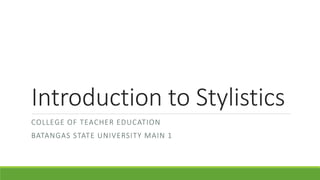
brief history of stylistics
- 1. Introduction to Stylistics COLLEGE OF TEACHER EDUCATION BATANGAS STATE UNIVERSITY MAIN 1
- 2. This course is offered to third year students as an introduction to the study of literary stylistics. This involves examining the language of literary texts in the three genres of poetry, prose, and drama, with a view to helping students arrive at a fuller understanding and appreciation of these texts.
- 3. Course requirements Each student is required to: 1. Take quizzes for the course and 4 major examinations on time 2. Regularly attend the class schedule 3. Submit any given assignment on time 4. Present an individual discussion of the topics given 5. Participate in interactive exercises and questions in each lesson by means of discussion 6. Submit one term paper: a stylistic analysis of a dramatic text or a narrative text chosen by the instructor
- 4. A brief history of Stylistics 1. Stylistics explores how readers interact with the language of (mainly literary) texts in order to explain how we understand, and are affected by texts when we read them. 2. The development of Stylistics, given that it combines the use of linguistic analysis with what we know about the psychological processes involved in reading, depended (at least in part) on the study of Linguistics and Psychology (both largely twentieth-century phenomena) becoming reasonably established.
- 5. Fowler, Roger (ed.) (1966) Essays on Style in Language. London: Routledge and Kegan Paul. Freeman, Donald C. (ed.) (1971) Linguistics and Literary Style.New York: Holt, Rinehart & Winston. Leech, Geoffrey N, (1969) A Linguistic Guide to English Poetry. London: Longman. Sebeok, Thomas A. (1960) Style in Language. Cambridge, Mass.: MIT Press.
- 6. Perhaps the most influential article is that by Roman Jakobson in Sebeok (1960: 350-77). It is called 'Closing Statement: Linguistics and Poetics' because it was a contribution to a conference which Sebeok (1960) published as a collection of papers.
- 7. ` Stylistics can be seen as a logical extension of moves within literary criticism early in the twentieth century to concentrate on studying texts rather than authors. Nineteenth-century literary criticism concentrated on the author, and in Britain the text-based criticism of the two critics I. A. Richards and William Empson, his pupil, rejected that approach in order to concentrate on the literary texts themselves, and how readers were affected by those texts.
- 8. This approach is often called Practical Criticism, and it is matched by a similar critical movement in the USA, associated with Cleanth Brooks, René Wellek, Austin Warren and others, called New Criticism. New Criticism was based almost exclusively on the description of literary works as independent aesthetic objects, but Practical Criticism tended to pay more attention to the psychological aspects involved in a reader interacting with a work.
- 9. In the early years of the twentieth century, the members of the Formalist Linguistic Circle in Moscow (usually called the Russian Formalists), like I. A. Richards, also rejected undue concentration on the author in literary criticism in favour of an approach which favoured the analysis of the language of the text in relation to psychological effects of that linguistic structure.
- 10. Why "Stylistics" ? The term 'Stylistics' became associated with detailed linguistic criticism because, at the time it developed, the study of authorial style was a major critical concern, and linguistic analysis, allied to statistics, was popular with the more linguistically inclined critics. To some degree, it is a less happy name now, as stylisticians have, by and large, moved away from the study of style and towards the study of how meanings and effects are produced by literary texts. There have been a few attempts to change the name of the enterprise: for example to 'literary linguistics' or 'critical linguistics'. But none of the labels so far proposed covers all the aspects of field adequately (for example the two just mentioned can just as easily apply to areas not covered by Stylistics and do not adequately represent the psychological aspects of the approach), and so 'Stylistics' has survived as the most popular label, despite its shortcomings.
- 11. The course is divided into four major topics specifically divided into: 5.1.1. Introduction to Stylistics 5.1.2. Poetry 5.1.3. Prose 5.1.4. Drama
- 12. Teaching and Learning Strategies Discussion Question and Answer Lecture/ Individual reportage Audio-Visual presentations Analysis of Literary Texts Sharing of Insights Assessment Methods Paper and Pencil (e.g. quizzes, long tests, etc.) Oral test Graded Oral Recitation Group Presentations Major Examinations
- 13. Students are required to pass the following as major requirements for the subject. Failure to submit the following is equivalent to a grade of INCOMPLETE. 8.2.1. Analyses of the following: 7.2.1.1. Cask of Amontillado 7.2.1.2. Tell-tale Heart 8.2.2. Student Written Outputs: 7.2.2.1. A Term Paper
- 14. Barry, Peter.2002.Beginning Theory: an introduction to literary and cultural theory. New York: Manchester United Press Leech, G.N. and Short M.2007. Style in Fiction, 2nd edition. Longman Simpson, P.2004. Stylistics: a resource book for students. Routledge ACADEMIC INFRASTRUCTURE Textbook: No textbooks for this course. References:
Editor's Notes
- Stylistics, then, is a sub-discipline which grew up in the second half of the twentieth century: Its beginnings in Anglo-American criticism are usually traced back to the publication of the books listed below. Three of them are collections of articles, some of which had been presented as conference papers or published in journals a little earlier:
- Jakobson is an important figure who connects together various strands in the development of Stylistics.
